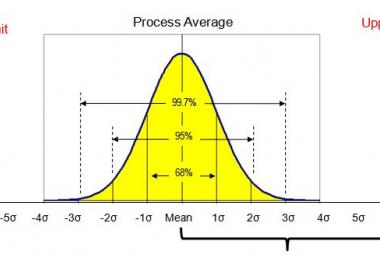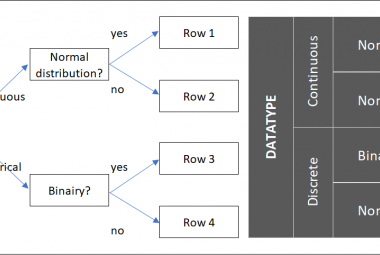In his book, creating a Lean R&D system, Terence Barnhart describes how the lean philosophy can be translated into a R&D environment. Barnhart himself is especially fond of the following three lean tools: A3 thinking, the Critical Question Analysis (CQA) and Value Stream Mapping (VSM). These are the three tools that help break barriers in an innovative environment because they help individuals look at a process the same way. This article there focusses on these three tools that are described in the book.
Lean manufacturing is about IMPROVING THE FLOW of a product or service through a process. The time between the start and the end of the process is measured and will be reduced after improvement workshops are implemented. The shorter lead times will in turn lead to lower costs, better quality and more reliable deliveries.
Barnhart describes, that within R&D, the product that is being created are packages of knowledge. The faster the complete package of knowledge is created, the sooner a new product can be introduced into the market and therefore create revenue.
The largest hurdle within R&D project work, can be found in the mental models that every individual has (Barnhart, 2013). When a team needs to make a decision about the new product design for instance, reaching consensus can take a lot longer when the team members have different views on the product, which then need to be discussed, delaying the project.
Lean R&D should therefore focus on using tools that help reduce these barriers of mental models. Tools like A3 thinking, the Critical Question Analysis and Value Stream Mapping help team members to look at a process from the same perspective, which reduces the need for the above described discussions.
The A3 PRINCIPLE is the first of three important tools within R&D. Lean Thinking has everything to do with solving problems and A3 thinking is the tool to solve problems in a scientific manner. Within R&D, finding the right design solution can be defined as a problem, for which A3 can be the method to use. Barnhart splits the A3 form in 4 parts:
Section1: the problem definition. In this section, the problem is described, quantified in terms of money, hours or motivation, and the corresponding improvement goals. Note, that the problem does not necessarily need to be solved 100% in the first improvement round. It could be a goal of reducing its occurrence with an X percentage, or to reduce the negative effect with an X percentage.
Section 2: the current situation. In this section, the current state of the process is described. Questions like “when does the problem occur?” and “where do they occur?” and “how often?” are answered in this section. This section can also include information found in literature that can help understanding the current situation.
Section 3: the root cause analysis. This is the section in which data is analyzed to find the possible root causes of the problem. Within the scientific method, it is perfectly ok to start experimenting already, to find out where the root cause can be found. This means, that it is also possible for the (currently believed to be) root causes to change over time.
Section 4: the learning plan. This is the section in which experiments are planned to validate the root causes in section 3 and possible solutions for them. The reference to learning in the name of this section points out, that also in this section, the experiments can change over time until the in section 1 defined problem is really solved.
The second tool that Barnhart writes about because it helps a team look at a process through the same eyes is VALUE STREAM MAPPING.
This tool is useful for repetitive projects or products. Only when a part of a project is repeatedly done, or a part of a product is regularly redesigned, it makes sense to create a value stream map. For parts of a project that are only done once, or products that are only designed once, the critical question analysis (see next paragraph) is more helpful.
A VSM project consists of 3 phases: scoping, design and implementation. In the first phase, the goals of the improvements are determined. Why do we want to map this process? Where do we focus on? Only after answering these questions, the current state value stream map is created. In the third phase, the current state VSM is used to define a learning plan. What are the largest obstacles for flow?
Each of these barriers are then input for a 2 hour meeting in which A3 can be used to remove it (Barnhart´s version of a kaizen event).
For projects that are so new, that there is no standard way of doing it, Barnhart describes another tool: the CRITICAL QUESTION ANALYSIS. In short, this analysis visualizes all the questions that need to be answered to finish a project. Two other terms used to describe the CQA are the knowledge gap map and the learning gap map. There are five steps in the CQA:
1. Define a strategic goal for the team. Just as with value stream mapping, it is important that the team has a clear understanding of the goals of the analysis that is about to be made. Creating clarity on the goals beforehand also helps to define who needs to be part of the workshop.
2. Brainstorm. In the CQA event, the team starts by listing as many questions that need to be answered to finish the project as possible.
3. Sort the questions. In this phase, the questions from step 2 are sorted in different clusters, including main and sub questions. Even better would be to already sort them in the sequence in which they need to be answered.
4. Review the results. Check whether the sequence is correct, if there are no overlaps in the clusters and if all questions are really necessary to achieve the goals defined in step 1.
5. Repeat step 2-4 until the team is satisfied with the results. Just as value stream mapping, the CQA is an iterative process, of which the results should be improved until there is a robust result.
In Creating a Lean R&D Systems, emphasis is put on mental models and how they influence team work. Barnhart mentions that teams in an organization should be like a group of good friends or professional athletes, who can act together without needing long discussions or communication, because they all act from the same mental model. Using the tools described in this book, teams can actually learn to look at a problem using the same mental model and therefore speed up any project work. I can therefore recommend this book for managers and people who work in a project environment, to help them reflect about how their teams operate.
Continue to:
Making Materials Flow - R.Harris, C.Harris C. & W.Wilson (summary)
REFERENCE
Barnhart, T. M. (2013). Creating a Lean R&D System - Lean Principles and Approaches for Pharmaceutical and Research-Based Organizations. Boca Raton: CRC Press. (order this book)












